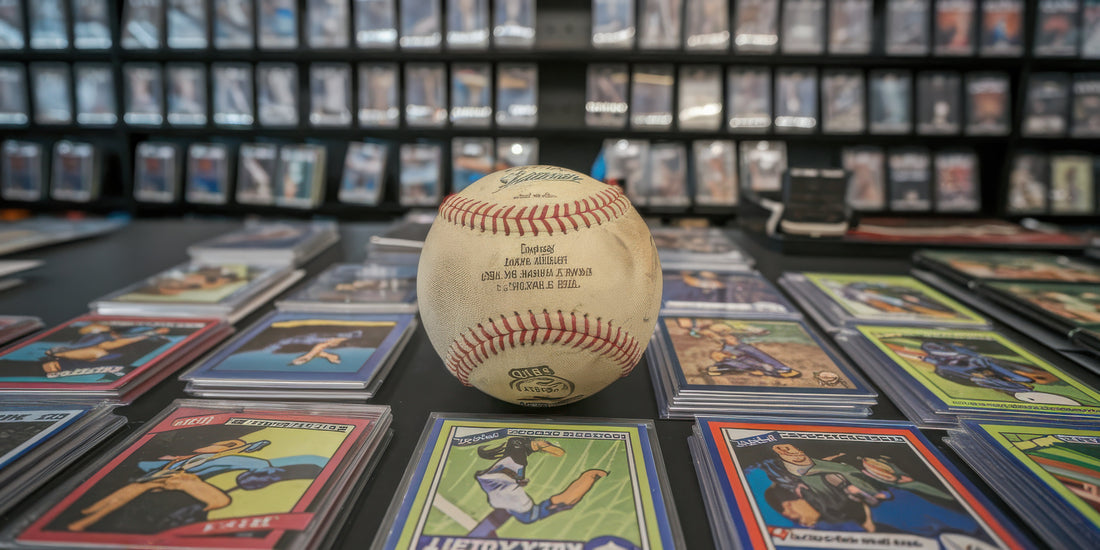
A Beginner’s Guide to Collecting Sports Cards
Share
Thinking of dipping your toes into the world of sports card collecting? You’re not alone. Whether you’re chasing iconic rookie cards, building nostalgic sets, or exploring potential investments, sports card collecting has something for everyone. Let’s walk through everything you need to know to get started confidently.
Why Collect Sports Cards?
Sports card collecting offers a rewarding blend of history, excitement, and discovery. Each card is more than just a picture; it’s a snapshot of athletic triumph, a portal to cherished memories, and sometimes, a valuable asset. Enthusiasts of all ages find joy in the hunt for special cards, the stories behind them, and the community that shares this passion.
- For fans, cards offer a tangible connection to favorite teams and players.
- Collectors enjoy the thrill of completing sets and finding rare gems.
- Many see it as a smart, enjoyable investment avenue.
Understanding the Basics
Before you rush out to buy your first pack, it helps to understand the foundational principles of sports card collecting.
- Sports Covered: While baseball cards are most historic, you’ll find thriving markets for basketball, football, hockey, soccer, and even niche sports.
- Types of Cards: The world of sports cards includes base cards, inserts, parallels, autographed cards, memorabilia cards (jersey or patch), rookies, and graded cards.
- Key Attributes: Card manufacturer (like Topps, Panini, or Upper Deck), year, set, player depicted, and card condition are critical identifiers.
Learning card terminology early on will help you make informed choices and avoid confusion as your collection grows.
Setting Goals for Your Collection
Before buying anything, decide what you want from your collecting journey. Are you focused on your favorite players, building team sets, chasing rookies, or targeting cards with strong investment potential? A clear goal shapes your approach and budget.
- Player Collectors: Focus on athletes you admire.
- Set Builders: Aim to complete a full-release year or series.
- Investors: Research valuable cards and market trends.
- Nostalgic Collectors: Hunt for cards from your childhood or family favorites.
Determining your focus now helps streamline purchases and reduces the chance of being overwhelmed.
How to Start Your Collection
Starting your collection can be as simple or as strategic as you like.
- Buy Retail Packs or Blaster Boxes: These are readily available and perfect for familiarizing yourself with modern cards.
- Shop Local Card Stores: Brick-and-mortar shops remain a staple of the hobby, often offering single cards, hobby boxes, and events.
- Online Marketplaces: Trusted platforms let you browse singles or lots and connect with a global community.
Whatever method you choose, start small. Explore different options and see what excites you most before investing significantly.
Understanding Card Grading and Condition
Card condition plays a huge part in both value and enjoyment. Most cards are judged on centering, edges, corners, and surface. You’ll often see grades like “Mint” or “Near Mint” from professional services.
- Raw Cards: These haven’t been graded and often cost less.
- Graded Cards: Authenticated and scored (commonly 1-10) by companies such as PSA, Beckett, or SGC. High grades usually fetch higher prices.
When handling cards, use clean hands, penny sleeves, and top loaders for protection. Good habits protect your investment and keep your cards looking sharp.
What Makes a Card Valuable?
Not every card will fetch top dollar, but some possess features that drive interest and price.
- Player Popularity: Superstars, Hall of Famers, and rookies command more attention.
- Scarcity: Short prints, limited parallels, and autographed cards are often more valuable.
- Condition: Mint or gem mint cards stand out.
- Age and Rarity: Vintage cards, especially from the ‘40s–‘80s, can be highly prized.
- Market Trends: Popularity of particular sports, players, or seasons can cause prices to fluctuate.
Value isn’t just about money. Sentimental cards can hold deep personal meaning, and many find as much joy in nostalgia as in appraising market worth.
Storing and Displaying Your Cards
Proper storage is essential for preserving both value and memories.
- Sleeves and Top Loaders: Basic yet effective protection for most collectibles.
- Binders and Pages: Great for organizing sets or showcasing favorite teams.
- Card Boxes: Useful for larger quantities and set storage.
- Humidity and Sunlight: Keep cards in cool, dry areas away from direct light.
Display options are as creative as you are—wall frames, shadow boxes, or desktop stands let you show off prized pieces safely.
Avoiding Common Mistakes
Many beginners make similar missteps early on. Here are some to watch for:
- Overbuying Blasters: Retail packs may not yield the rare cards seen on social media.
- Ignoring Card Condition: Even minor flaws can drastically reduce value.
- Falling for Fakes: Stick to reputable sellers and learn how to spot counterfeits.
- Impulse Buying: Take the time to research before making big purchases.
- Neglecting Organization: A system makes enjoying, trading, and insuring your collection easier.
Learning from the experience of others can save you money and disappointment as you build your collection.
Connecting with the Sports Card Community
Collecting cards is more enjoyable as part of a community. Enthusiasts are generous with trades, stories, and advice.
- Local Card Shows: Meet other collectors, discover rare finds, and attend break sessions.
- Online Forums and Social Media: Platforms like Reddit, Instagram, and dedicated fan sites foster conversation and peer support.
- Trading Groups: Swap cards, learn values, and make new friends.
By joining these circles, you gain knowledge, access exclusive opportunities, and can even find mentors to guide your collecting journey.
Keeping Up with Trends and News
Sports card collecting is always evolving. Staying informed helps you find great deals and anticipate market shifts.
- Follow Industry News: Blogs, podcasts, and YouTube channels discuss releases, values, and hobby updates.
- Watch Player Performance: Breakout stars and milestones often spike demand and value.
- Understand Release Schedules: Knowing when new products drop helps with budgeting and planning.
Continual learning gives you an edge—whether you’re collecting for fun or looking to build wealth through your cards.
Your Next Steps in Sports Card Collecting
Now that you know the essentials, it’s time to put your knowledge into action. Remember, there’s no single “right” way to enjoy this hobby. Set a budget, define your interests, and let curiosity be your guide.
- Start small and experiment.
- Protect your cards from the beginning.
- Engage with both local and online communities.
- Learn as you go and don’t be afraid to ask questions.
With patience and enthusiasm, your collection will become a source of pride and enjoyment for years to come.
Conclusion
Sports card collecting offers endless possibilities for fun, nostalgia, and connection. Whether you’re in it for passion or potential profit, this beginner’s guide to collecting sports cards puts you on solid footing. Explore, learn, and enjoy every pack you open!
